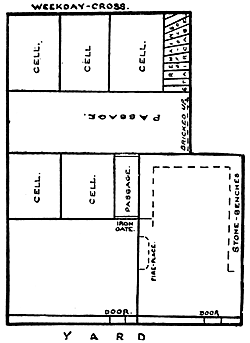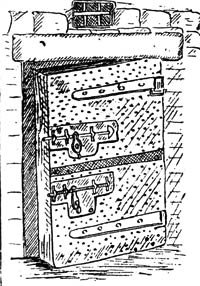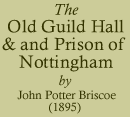III.

WYLIE tells us that in 1853 the Council Chamber was about to be enlarged. The old Guild Hall continued to comprise a Council Chamber until 1877, in which year, on September 24th, the last meeting of the local governing body was held here. Owing to the extension of the borough and the increase in the number of aldermen and councillors, the Council sought better accommodation, and on November 7th, 1877, the enlarged municipal body met in the Mechanics' Lecture Hall, Burton Street, which had been expressly fitted up for the purpose, and continued to do so up to and including August 11th, 1879. In the meantime, the Exchange Hall was being adapted as a Council Chamber, and was first used as such on August 15th, 1879, in which hall the "corporate fathers" have continued to sit and deliberate on municipal matters.
The Guild Hall continued to be used as a Court House until the opening of the New Guild Hall, Burton Street, in 1888. After that time, as it was beforetime, it was utilised as a place for holding town's meetings and for other purposes.
It should be recorded that the eastern portion of the Guild Hall was demolished some years ago in order to make way for the erection of a warehouse. For this purpose the building was shortened from nine pillars in frontage to seven, which was the length when it was razed to the ground.
WEEKDAY CROSS.
For the purposes of the new branch of the Manchester, Sheffield, and Lincolnshire Railway, the site was required, so negotiations were entered into for the purchase. Soon after the passing of the Act of Parliament this was completed; and, "at the invitation of the local agent of the railway company, a select party of residents of the town paid a visit of inspection to the old structure, whither so many unwilling visitors have been haled in days of yore. After inspecting the courts, the party proceeded below, visiting the five cells, or dungeons as they may be more properly termed, wherein offenders in days past were wont to be incarcerated. The exercise yard, in the corner of which is the grave of a man who expiated the crime of murder half a century since, was also perambulated, while in the "day room," the numerous names and initials carved by prisoners on the slab immediately over the fireplace naturally created much interest. The opinion was general among the visitors that the slab already mentioned and at least one of the dungeon doors ought to be preserved to the town."

The site having to be cleared at a very early date, the building materials as they stood were offered by the railway company for sale on November 12th, 1894. The building included the court room, grand jury room, retiring rooms, warders' rooms, and prison cells. Four dilapidated tenements near the Town Hall, on the eastern side of Middle Hill, were included in the sale. Mr. F. W. Kidd, the auctioneer, stated that "the brickwork was very thick; there was a good lot of lead on the roof, the inside of which was of pitchpine, and the fittings were in a good state of preservation. The cell doors were of oak, with iron studs, and there might be gentlemen present anxious to get one as a curiosity. Then there was the debtors' yard and debtors' room, over the fireplace of which was a great curiosity in the shape of a stone on which the names of inmates were carved; and in the yard was the stone which marked the grave of a man who did a dire and dreadful deed. Someone else might be found—perhaps a lady, and then there would be a pair." The first bid was £5. When £50 was reached there was a lull in the bidding. Then £10 more were offered, and at £70 the materials of the old Town Hall were "knocked down " to Mr. R. T. Widdowson, chemist, Carrington, Nottingham. The clock bell had previously been given to Aid. Sir John Turney, and the bell sold to Councillor Perry for £9.

It was stated after the sale that there was an entrance on the site to a subterranean passage which was supposed to lead to Beck Street. After some search the workmen, on November 28th, to quote the editor of The Nottingham Express "Local Notes and Queries" column, "came across what are supposed to be dungeons which, judging from their surroundings, have been closed for many years. In the large room—the justice room—the workmen descended some wooden stairs, which apparently led only to the cells. Upon examining the place more closely, however, it was discovered that at the bottom of the staircase was a large flag-stone, which, on being sounded, showed that there was a hollow space below. The stone was therefore removed, when it was found that there were a number of steps leading clown to the dungeons. Here the workmen found themselves in a noisome cave, the dimensions of which were about 12ft. by 51/2ft. A few feet from this one was found another of similar capacity. An interesting feature about the subterranean dungeons is the initials on the ceilings, made apparently by the smoke from a candle. Some of the initials are evidently those of criminals who have been executed in Nottingham. A little to the left of the dungeons already described there were found another stone, similar to the one mentioned above, and this was found to have blocked the way to another flight of steps. Upon descending these, a dungeon was found which differed from those first visited only in one respect, namely, that it was a little larger, and that there were ledges on either side. At the far end of this dungeon, however, there is a little brickwork which appears to block up some other passage, and it was thought probable by many that this might lead to the underground passage which is supposed to exist, although it opens out apparently in an opposite direction to Beck Street. Nothing further has been discovered with regard to the subterranean passage, but diligent search is being made."
The whole of the premises were thrown open for the inspection of the general public upon payment of a small fee, and the opportunity was availed of by several thousands of residents and visitors.
Before the actual work of stripping and demolition had commenced, a smoking concert was held in the old Court room, and was largely attended. This was on Wednesday, November 28th.
The fittings were sold by auction on Monday, December 3rd, 1894, by the purchaser of the structure. Considerable interest was displayed in the proceedings. Of this the local Express thus reports: — "The sale was a very interesting one, and some rare old relics were brought to light. The door of the condemned cell fetched top price, Sir John Turney securing the massive ironbound oak portal for six pounds ten shillings. The carved stone slab in the debtor's prison was knocked down for three pounds five shillings to the representative of a London firm of antique merchants. The reporter's box, with two doors, seat, &c., in the Criminal Court, only realised four shillings and sixpence; but the one which used to be occupied by members of the fourth estate in the Summons Court fetched sixteen shillings, this one being booked for London. The judge's seat fetched three pounds five shillings, while the prisoner's dock, surmounted with iron spikes, was knocked down for twenty-three shillings. The gaoler's and usher's chairs sold for eleven and eighteen shillings respectively. The witness box in the Summons Court, from which it is alleged Lady Clifton once gave evidence, was bid for spiritedly, and sold for twenty-five shillings. County Councillor Anderson secured the solicitors' table in the same court for sixteen shillings. The door and partition leading to the cells went rather cheaply, for eleven shillings; and the old iron gates, through which so many hundreds of prisoners have in the past exchanged greetings with their friends, realised but twenty-two shillings. In addition to the condemned cell floor, others fetched thirty-five, forty-five, forty, and sixty-five shillings respectively. Two massive rings, by means of which prisoners were at one time secured to the walls, fetched three shillings, and the steps leading out of the graveyard two shillings and sixpence The thick loopholed oak door in Weekday Cross was disposed of for six shillings. The old oak columns in Weekday Cross sold at sums varying from five shillings and sixpence to twelve shillings and sixpence each, the iron pillar realising six shillings. The entrance steps, iron railings, and gate fetched twenty-three shillings, and the two old-fashioned lamps seven shillings."-
The purchasers began to take their fittings away on the following day. The whole ground was cleared by the end of January of the present year. During February the railway contractors had sunk a shaft here, and the old order of things had made way for the new.
By the courtesy of Councillor Fleeman we are enabled to give an illustration of the Guild Hall immediately before its demolition. This was taken from a photograph by Mr. G. W. Simons. The plans of the police court and of the prison and the sketch of one of the prison doors are from drawings by my son, Mr. Walter A. Briscoe, taken from sketches by Mr. H. Barnett.
